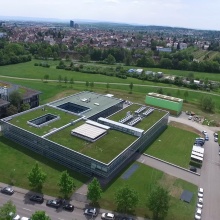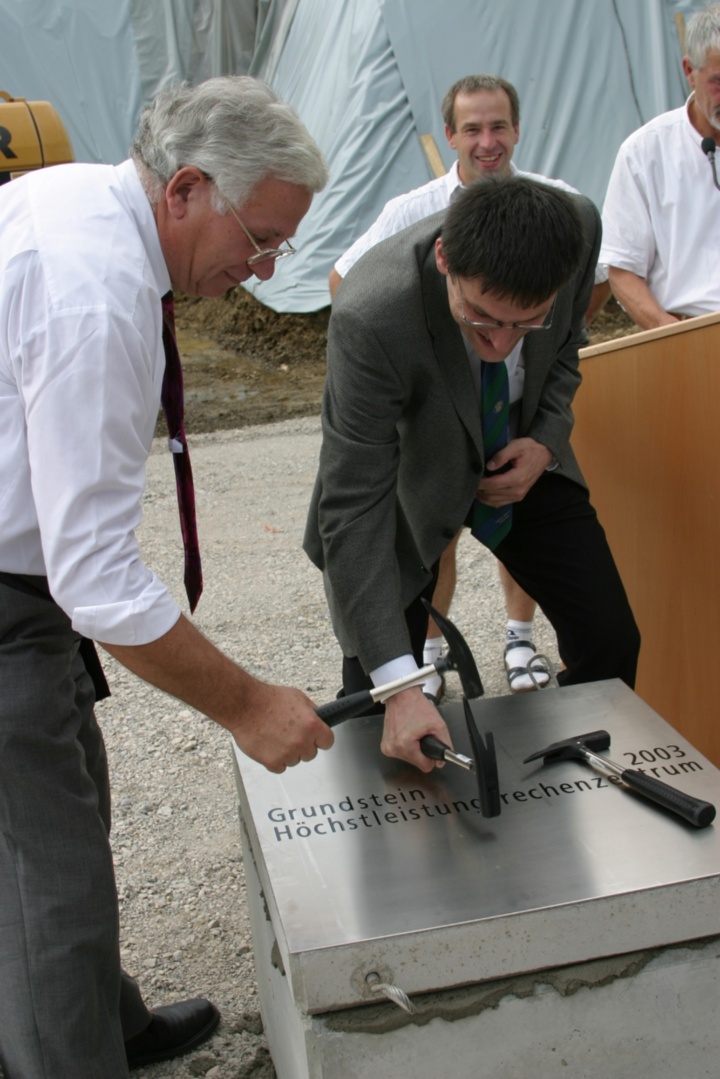Founded in 1996 as Germany's first national high-performance computing (HPC) center, the High-Performance Computing Center Stuttgart (HLRS) has grown to become not just a key facility of the University of Stuttgart but also an internationally prominent center for research involving simulation, visualization, and data analytics. Today, HLRS marks the 25th anniversary of its creation, highlighting its important role in powering scientific discovery, supporting industrial competitiveness, driving technical evolution, and meeting global challenges.
Professor Wolfram Ressel, Rector of the University of Stuttgart, congratulated HLRS on its anniversary: "The high-performance computing center is a prominent example of the University of Stuttgart's excellent research infrastructure. For more as a quarter century Stuttgart's supercomputing has stood at the pinnacle of scientific and technological progress and is synonymous with visionary research and education, as well as for technology transfer in support of prosperity in industry and society. On the occasion of its anniversary celebration I congratulate all of the researchers who on a daily basis contribute to these exciting efforts for their internationally recognized achievements."
German Federal Minister of Education and Research Anja Karliczek also extended her congratulations on the anniversary: "High-performance computing is an important cornerstone for building technological sovereignty in Germany and Europe. By making reliable investments in the research and development of digital technologies we are ensuring our competitiveness. HLRS has been engaged at the intersection of science and industry for more than 25 years and again and again its supercomputers have enabled ground-breaking achievements, for example in the simulation of more energy efficient airfoils. The high level of commitment of the staff at HLRS is crucial to this great success: thanks to them, algorithms and supercomputers are transformed into excellent research and innovation."
"The High-Performance Computing Center at the University of Stuttgart is among the largest and most important facilities for supercomputing worldwide," said Baden-Württemberg Minister of Science Theresia Bauer. "The past 25 years at HLRS have been a remarkable success story and its international visibility is of upmost importance for the state as a center for research. In its role as a competence center, HLRS is active in almost all areas of research, from engineering to the digital humanities, and makes essential contributions to key political fields such as the transition underway in the energy sector and the development of more environmentally sustainable mobility solutions."
Delivering essential solutions for science and industry
HLRS was established to provide essential infrastructure for the most computationally demanding academic research across Germany. Since then, its increasingly powerful supercomputing systems and expertise in high-performance computing have supported countless large-scale research projects from across Germany and Europe. Scientists rely on HLRS for the computing power necessary to improve wind turbine efficiency, develop models of weather and climate change, or investigate fundamental physical features of the universe, to name just a few areas.
At the same time, providing powerful HPC solutions for industry has long been a central part of HLRS's mission. Working with its partner organizations HWW (Höchstleistungsrechner für Wissenschaft und Wirtschaft) and SICOS BW, HLRS has made its world-class computers and expertise in simulation, visualization, and data analytics available for companies of all sizes to help them become more globally competitive. Over the years it has also searched for and focused on new application areas in which in which its solutions could promote innovation. This has included developing Solution Centers focusing on the automotive, media arts, and medical technology sectors. Also important are HLRS's comprehensive HPC training and user support programs, which over the decades have helped many thousands of European scientists in both academic and industrial research to acquire the skills needed to use high-performance computing effectively.
Supporting European excellence and meeting global challenges
Together with its partners in the Gauss Centre for Supercomputing — the alliance of Germany's three national supercomputing centers — HLRS has grown to become a prominent fixture in the European HPC community, contributing to initiatives aimed at promoting pan-European scientific excellence including the Partnership for Advanced Computing in Europe (PRACE), the EuroHPC Joint Undertaking, and GAIA-X. As coordinating center of the EuroCC, CASTIEL, and FF4EuroHPC projects, HLRS is currently leading efforts to expand HPC expertise in Europe and promote collaboration across national borders.
With nearly 100 scientists on staff, HLRS also conducts collaborative research to explore how HPC and related technologies can provide practical solutions for addressing complex global challenges. In recent years the center has been an essential partner, for example, in developing new computing and data management infrastructures for modelling natural disasters, increasing productivity in agriculture, and predicting intensive care unit demand during the Covid-19 pandemic.
Computing for a more sustainable future
According to HLRS Director Prof. Dr. Michael Resch, the demand for larger supercomputers, the emergence of new technologies like artificial intelligence and quantum computing, and the urgent need to make HPC more environmentally sustainable are three key factors that will drive HLRS's continuing evolution over the coming decade.
"As HLRS plans for its next-generation supercomputer, which we hope to inaugurate in 2026, we will face the twin challenges of constructing a new building and developing a new energy infrastructure that will meet the new supercomputer's significantly larger power requirements," Resch said. "A focus on maximizing efficiency will be particularly important as HLRS builds on its recent EMAS and Blue Angel certifications for environmental and energy management, and works toward the goal of becoming carbon neutral by 2032." Considering the role that simulation and data analysis have played in the global response to the ongoing Covid-19 pandemic, HLRS is also focused on addressing a growing need for urgent supercomputing resources that can be deployed quickly in crisis situations.
"Today is a day to look back with pride at what HLRS and its many partners have accomplished over the last 25 years," Resch said. "At the same time we look forward to continuing to provide new kinds of resources and solutions that will help scientists, technology creators, public administrators, and others across our society to address the many challenges that we face."
About the High-Performance Computing Center Stuttgart
The High-Performance Computing Center Stuttgart (HLRS) was established in 1996 as the first German national high-performance computing center, building on a tradition of supercomputing at the University of Stuttgart that stretches back to 1959. As a research institution affiliated with the University of Stuttgart and a founding member of the Gauss Centre for Supercomputing — the alliance of Germany's three national supercomputing centers — HLRS provides state-of-the-art HPC services to academic users and industry. HLRS operates one of Europe's most powerful supercomputers, provides advanced training in HPC programming and simulation, and conducts research to address key problems facing the future of supercomputing. Among HLRS's areas of expertise are parallel programming, numerical methods for HPC, visualization, grid and cloud computing concepts, data analytics, and artificial intelligence. Users of HLRS computing systems are active across a wide range of disciplines, with an emphasis on computational engineering and applied science.
Expert Contact:
Prof. Dr. Michael Resch, University of Stuttgart, High-Performance Computing Center Stuttgart
Phone.: +49 (0) 711 / 685-87200
Mail



